

Digitised Armorials – Heraldica Nova. Wolfenbüttel, Herzog August Bibl., 120 Extrav., f.165v Hermann Botes Schichtbuch, produced in the 1510s, contains a rarely researched elaborate armorial in the last section of the manuscript.
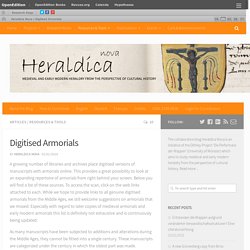
The armorial holds a wide range of coats of arms, including those of the Hanse Kontors, cities that were members of the Hanseatic League, Saxonian nobles and inhabitants of Braunschweig, where the armorial was very probably produced. Furthermore, the manuscript describes some legends on the development of Saxonian coats of arms, accompanied by the coats of arms in question. For more information, see the blogpost on this armorial. Weblink: Literature: Herbert Blume, ‘Das Schichtbuch. Ludwig Hänselmann, ‘Das Schichtbuch. 1514.’ in: Die Chroniken Der Niedersächsischen Städte.
Elmar Hofman, “A treasure hidden in plain sight. Elmar Hofman, ‘Armorials behind the Schichtbuch. Object moved. Content Parchment roll comprising four pieces of parchment, with 324 shields arranged in 54 rows of 6 each.
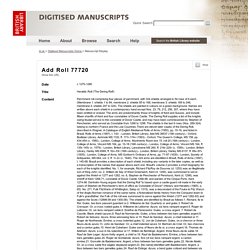
(Membrane 1: shields 1 to 84; membrane 2: shields 85 to 168; membrane 3: shields 169 to 246; membrane 4: shields 247 to 324). The shields are painted in colours on a green background. The Danish Democracy Canon. Identification “A land must be based on law”.

These are the introductory words of the Jutland Code, which is the most important of the Danish provincial codes. It was officially granted by King Valdemar II, the Victorious (ruled 1202-1241) in 1241 as one of his last acts, and it was adopted by his council consisting of the kingdom’s nine bishops. One of these was the 90-year-old Gunnar of Viborg (1152-1251), who is believed by many to have written the famous introductory words of the Code. Olaus Magnus. Olaus Magnus (October 1490 – August 1, 1557) was a Swedish writer and Catholic ecclesiastic.
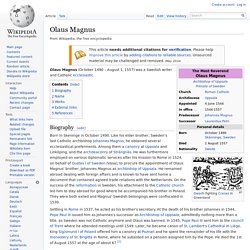
Biography[edit] Name[edit] His original Swedish name was Olof Månsson (his last name meaning "son of Mån"; Magnus is a Latinized version of his patronymic second name, and not the literal personal epithet meaning "great").[1][2] Works[edit] He is best remembered as the author of the famous Historia de Gentibus Septentrionalibus (History of the Northern Peoples), printed in Rome 1555, a patriotic work of folklore and history which long remained for the rest of Europe the authority on Swedish matters.
It included a map of Northern Europe with a map of Scandinavia, which was rediscovered by Oscar Brenner in 1886 in the München state library and shown to be the most accurate depiction of its time. Following the death of his brother, he also let historical works that the brother had written be published. External links[edit] Drømmen om hjemlandet [The dream about the country of origin] References[edit] Historia de gentibus septentrionalibus. EARVMQVE DIVERSIS STATIBVS, CONDITIONIBVS, MORIBVS, RITIBVS, SVPERSTITIO, nibus, disciplinis, exercitiis, regimine, victu, bellis, structuris, instrumentis, ac mineris metallicis, & rebus mirabilibus, necnon vniuersis pene animalibus in Septentrione degentibus, eorum cp natura.
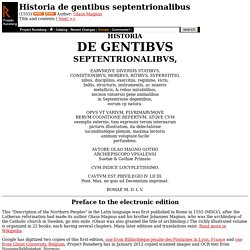
OPVS VT VARIVM, PLVRIMARVMQVE RERVM COGNITIONE REFERTVM, ATQVE CVM exemplis externis, tum expressis rerum internarum picturis illustratum, ita delectatione iucunditatéque plenum, maxima lectoris animum voluptate facile perfundens. AVTORE OLAO MAGNO GOTHO ARCHIEPISCOPO VPSALENSI Suetiæ & Gothiæ Primate. CAVTVM EST PRIVILEGIO IV LII III: Pont. Max. ne quis ad Decennium imprimat.
Olaus Magnus. Un article de Wikipédia, l'encyclopédie libre.
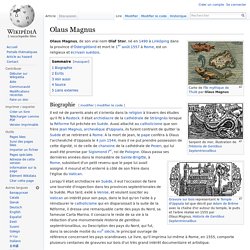
Olaus Magnus, de son vrai nom Olaf Stor, né en 1490 à Linköping dans la province d'Östergötland et mort le à Rome, est un religieux et écrivain suédois. Biographie[modifier | modifier le code] Il est né de parents aisés et s'orienta dans la religion à travers des études qu'il fit à Rostock. Il était archidiacre de la cathédrale de Strängnäs lorsque la Réforme fut prêchée en Suède. Aussi attaché au catholicisme que son frère Jean Magnus, archevêque d'Uppsala, ils furent contraint de quitter la Suède et se retirèrent à Rome. Lorsqu'il était archidiacre en Suède, il eut l'occasion de faire une tournée d'inspection dans les provinces septentrionales de la Suède. Écrits[modifier | modifier le code] Historia de Gentibus Septentrionalibus. Un article de Wikipédia, l'encyclopédie libre.

L'Historia de Gentibus Septentrionalibus, en français Histoire des peuples du Nord, est une œuvre monumentale de Olaus Magnus sur les pays nordiques, rédigée en latin et imprimée à Rome en 1555. Cet ouvrage est resté longtemps pour le reste de l'Europe la référence pour tout ce qui touchait la Suède. Son succès fut accru par les nombreuses petites gravures sur bois (quasiment une par page), qui représentent les peuples nordiques et leurs coutumes étranges, qui étonnèrent l'Europe entière. Il fut traduit en italien, (1565), allemand (1567), anglais (1658) et néerlandais (1665).
Des résumés parurent à Anvers (1558 et 1562), Paris (1561), Amsterdam (1586), Francfort (1618) et Leiden (1652). Il reste de nos jours un répertoire important de nombreuses informations curieuses sur les us et coutumes et le folklore scandinaves. Quelques-unes des nombreuses gravures qui égayent l'ouvrage : Codex Holmiensis. Text of the Codex Holmiensis manuscript.
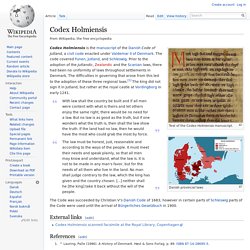
Diplomatarium Danicum. List of the Rolls. Contents In the section European Rolls of Arms I have consulted a total of seventeen rolls.

They are listed below, with a brief description of the likely date, present location, type, and the main source of my study. The pages of the Caerlaverock Poem & The Falkirk Roll have references to other places where arms are found. There are links to each of the individual pages of the rolls as published on the site. The Dering Roll (A) British Library. Last quarter of the 13th century. Glover's Roll (B) The First Nine Books of the Danish History of S... Liber census Daniæ, Kong Valdemar den andens jordebog, ndg. og oplyst af O. Nielsen : Waldemar. The nine books of the Danish history of Saxo Grammaticus : Saxo, Grammaticus, d. ca. 1204.